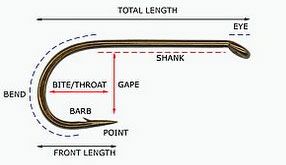


The size breakdown from smallest to largest looks like this:32, 30, 28, 26, 24, 22, 20, 18, 16, 14, 12, 11, 10, 8, 6, 4, 2, 1, 1/0, 2/0, 3/0, 4/0, 5/0, 6/0, 7/0, 8/0, 9/0, 10/0, 11/0, 12/0, 13/0, 14/0, 15/0, 16/0, 17/0, 18/0, and 19/0
Hook Description

The numbers that define hook sizes can be confusing, but the system is really very simple. Hook sizes are based on a nominal hook size of zero. Hook sizes with a number followed by a zero increase in size as the number goes up.
For instance a 4/0, ("four bar oh" or "four oh"), hook is one size up from a 3/0, which is one size up from a 2/0, etc.
Hook sizes not followed by a zero, decrease in size as the number increases.
For example a size 3 hook is smaller than a size 2 hook, which is smaller than a size 1 hook.
While nearly all hook manufacturers follow this basic numbering system to indicate the increase or decrease in size of each hook within an individual pattern, there is unfortunately little standardisation in overall sizes. For instance what may be a size 4/0 in a Mustad hook may not necessarily be the same as a 4/0 in a Gamakatsu hook.
However hooks for fly tying are much more standardised than saltwater hooks for instance.
For the purposes of this article, all hook-size recommendations are based on the Mustad hook sizes. As an aside, most writers in books and magazines appear to assume the Mustad standard hook sizes when alluding to or recommending hook sizes.
Treble and double hooks follow this sizing convention, that is, a treble or double hook is described by the size of any one of the hooks. For example a size 4/0 treble hook is made up of three 4/0 hooks.